Living and Learning Food Processing
PROCESSING PREVIEW
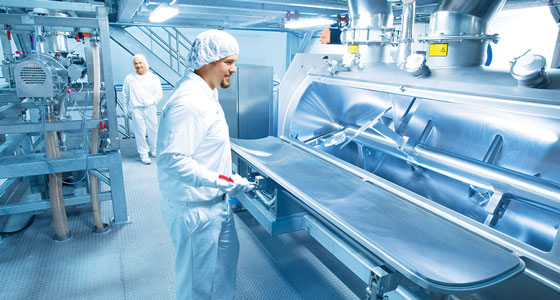
This year’s annual event promises to be both exciting and educational for those who wish to learn more about food processing. This column will provide a brief overview of the multitude of scientific sessions that reveal new research related to food processing. In addition to the symposia previewed here, there are numerous excellent poster sessions sponsored by IFT’s many divisions. Posters support learning about food processing and provide the means to interact directly with the researchers who performed the studies, providing a unique opportunity to delve deeper into their work and share knowledge and experience to further science.
I suggest that you take some time to wander at this year’s IFT annual event. To wander not only through the scientific sessions reviewed in this column and the food expo processing booths, which will be discussed in a future column, but to also wander through the poster sessions during the annual event. Wandering is an activity that many of us do not do frequently enough in our lives, an activity that is critical to exploration and one that consistently brings unexpected rewards. I hope that your wandering through this year’s IFT annual event brings you new insights and ideas into food processing.
Before highlighting specific scientific sessions, it is important to note that there will be two special short courses this year focusing on food processing. They are “Commercialization of Nonthermal Technologies, Challenges and Advances” and “Microencapsulation in Food Applications,” both of which occur all day on Friday, July 15. Both nonthermal processing and microencapsulation technologies are actively being commercialized to improve food quality, nutrition, and safety and these short courses are an excellent opportunity to learn both the basics and the state-of-the art related to them.
Food processing scientific sessions begin very early in the morning on Sunday, July 17. At 7:15 a.m. there are two sessions on food processing, “Microwave Thermal Processing, Recent Advances and the Next Chapter” and “Electron Beam Processing as a Platform Technology for the Food Industry” that I recommend to you early risers. Shortly after that at 8:30 a.m. there is another session titled “Can High Pressure Processing in Combination with Heat Serve as a Safe Alternative to Inactivate Clostridium Botulinum Spores?” Later that day at 2 p.m., the discussion of nonthermal processing continues with three concurrent sessions, “Emerging Nonthermal Separation Technologies,” “Advances, Challenges, and Opportunities in Nonthermal and Other Novel Food Processing Technologies: Engineering and Packaging Aspects,” and “Critical Considerations in Pathogen Surrogate Identification and Utilization for Nonthermal Food Process Testing and Food Safety Verification.” Clearly nonthermal processing is being highlighted at this year’s IFT annual event, likely due to the food industry’s desire to optimize nutrition and quality during processing. Also at 2 p.m. on Sunday, July 17, there is a fourth session related to food processing. This interesting session is titled “Formulation and Processing Challenges and Insights into the Development of New and Healthier-For-You Snacks.”
The program on Monday, July 18, is a bit lighter in terms of food processing. There is a session at 10:30 a.m. titled “Technology Transfer from Academia to Industry: Approaches and Case Studies” that will follow several food processing technologies through to commercialization. Another special symposium that morning, also at 10:30 a.m., is “The Science of Brewing Beer and How Policy Affects That Pint.” Later on Monday, sustainability will be highlighted at 12:30 p.m. in a symposium on “Engineering Sustainability and Water Conservation in Food Production.” Water use is one of the greatest challenges that the food processing industry is confronting at this time, and this session offers opportunities to learn ways to save water during food production. Biosensors can be important components in food manufacturing and there will be a session Monday at 2:15 p.m. on “Current Innovations in Biosensors for Food Quality and Safety.”
Tuesday, July 19, will start out with a symposium at 8:30 a.m. titled “Next Generation of Extrusion Processing: New Opportunities and Industrial Benefits.” Extrusion is used to produce many food products, and it will be interesting to learn how this traditional technology is being improved for current applications. There will also be a symposium titled “Hyperbaric Storage of Foods with No Temperature Control as a New Food Preservation Methodology and Possible Alternative to Refrigeration” concurrent with the extrusion session. Later that morning, light-based technologies will be highlighted during a session at 10:30 a.m. on “Recent Advancements in Light-Based Technologies for Enhancing Food Safety.” Finally, on Tuesday at 1:15 p.m. there will be an informative panel on “Food Engineering Solutions to Food Security in the Developing World.”
A wide range of novel research topics related to food processing will be presented during the scientific and poster sessions at this year’s annual meeting. I hope that you seize this opportunity to live and learn more about food processing through them. See you there.
--- PAGE BREAK ---
Exhibitor Information
The following are brief descriptions of some of the processing-related exhibits that will be on display at the IFT16 food expo.
Customized contract production of food ingredients and food supplements in powder form is available from SternMaid America. In addition to blending powders, the contract manufacturer offers copacking, warehousing, and logistics services. Liquid constituents can be applied homogeneously to powder through special nozzles in amounts ranging from 0.01% to 60% of the formulation. Microcomponents such as flavorings, oils, or emulsifiers are finely dispersed through atomizing spray nozzles, which enables high blending precision. Order sizes start at 500 lb; filling into bulk or consumer packaging sizes is available. SternMaid America, sternmaid-america.com, Booth 624
A mix of equipment, design, automation, service, and process engineering is available from Blentech. The company, a leading manufacturer of processing systems, has been in business for 30 years. Blentech is committed to a food first design approach to capital project development. Blentech, blentech.com, Booth 4442
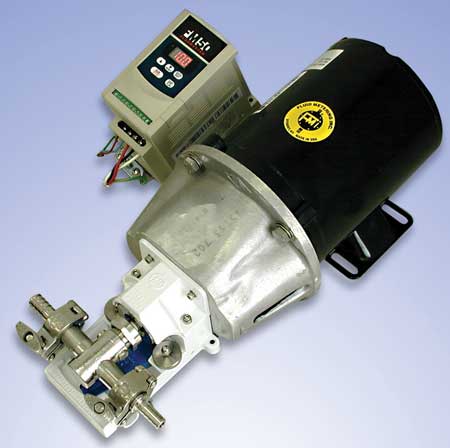 The valveless IVSP Industrial Variable Speed Metering Pump is well-suited for viscous fluids. The pump has a rugged variable speed drive motor and is available with sanitary quick-disconnect fittings. Its valveless function is achieved via the synchronous rotation and reciprocation of a ceramic piston within a precisely mated ceramic liner. The reciprocation action of the piston accomplishes the pumping function; the piston also rotates, alternately aligning a flat at the end with the inlet and outlet ports of the pump. When the flat is aligned with the inlet port, fluid can be drawn into the pump; when the flat is aligned with the outlet port, fluid can exit it. Fluid Metering’s valveless metering pumps facilitate the addition of vitamins, colors, flavors, fragrances, enzymes, and preservatives, among other ingredients. Fluid Metering, fmipump.com, Booth 2075
The valveless IVSP Industrial Variable Speed Metering Pump is well-suited for viscous fluids. The pump has a rugged variable speed drive motor and is available with sanitary quick-disconnect fittings. Its valveless function is achieved via the synchronous rotation and reciprocation of a ceramic piston within a precisely mated ceramic liner. The reciprocation action of the piston accomplishes the pumping function; the piston also rotates, alternately aligning a flat at the end with the inlet and outlet ports of the pump. When the flat is aligned with the inlet port, fluid can be drawn into the pump; when the flat is aligned with the outlet port, fluid can exit it. Fluid Metering’s valveless metering pumps facilitate the addition of vitamins, colors, flavors, fragrances, enzymes, and preservatives, among other ingredients. Fluid Metering, fmipump.com, Booth 2075
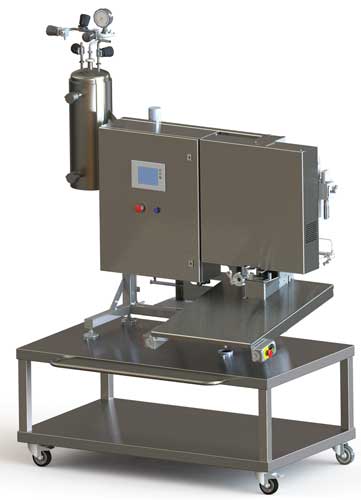 R&D processing equipment maker OMVE will highlight several new products at the food expo. The FS218 aseptic bag-in-box filler delivers waste-free filling thanks to its aseptic buffer tank. The new filler can be seamlessly integrated with any OMVE heat treatment systems, and bags ranging in size from 2 L to 20 L can be filled easily in under a minute. OMVE’s state-of-the-art MPV-FE fermenter facilitates the fermentation process via its automated time, temperature, and pH controls; no manual steps are required for mixing. The company also offers the CF310 carbonator for carbonating products with fruit pulps and fibers. Yet another OMVE equipment offering is its continuous ice cream freezer, the CRA223, which has been redesigned to improve yield and performance in processing ice cream mix. OMVE Laboratory & Pilot Equipment, omve.com, Booth 2012
R&D processing equipment maker OMVE will highlight several new products at the food expo. The FS218 aseptic bag-in-box filler delivers waste-free filling thanks to its aseptic buffer tank. The new filler can be seamlessly integrated with any OMVE heat treatment systems, and bags ranging in size from 2 L to 20 L can be filled easily in under a minute. OMVE’s state-of-the-art MPV-FE fermenter facilitates the fermentation process via its automated time, temperature, and pH controls; no manual steps are required for mixing. The company also offers the CF310 carbonator for carbonating products with fruit pulps and fibers. Yet another OMVE equipment offering is its continuous ice cream freezer, the CRA223, which has been redesigned to improve yield and performance in processing ice cream mix. OMVE Laboratory & Pilot Equipment, omve.com, Booth 2012
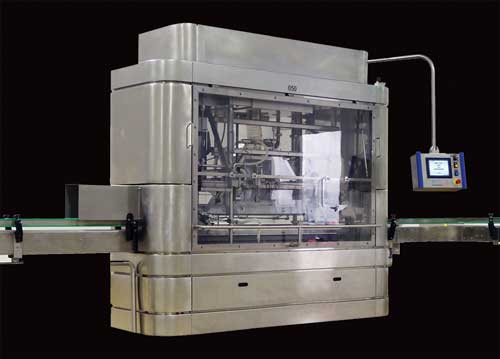 Aseptic laboratory fillers are new from MicroThermics, a leading supplier of small-scale UHT and HTST processing equipment and a past IFT Industrial Achievement Award winner. Fed by one of the MicroThermics’ processors, the new fillers automatically sterilize the filling chamber, continuously sterilize bottles and caps, and then fill and seal bottles under sterile conditions. The company’s intuitive operator interface control system features simplified navigation and operation. In addition, MicroThermics’ new Aseptiwave processors provide rapid controlled heating. Because there are no heated surfaces and no product-damaging shear, products are fresh-tasting and retain high levels of nutrients. MicroThermics’ processors are available with homogenizers, custom hold tubes, and ultra-clean fill hoods. MicroThermics, microthermics.com, Booth 2631
Aseptic laboratory fillers are new from MicroThermics, a leading supplier of small-scale UHT and HTST processing equipment and a past IFT Industrial Achievement Award winner. Fed by one of the MicroThermics’ processors, the new fillers automatically sterilize the filling chamber, continuously sterilize bottles and caps, and then fill and seal bottles under sterile conditions. The company’s intuitive operator interface control system features simplified navigation and operation. In addition, MicroThermics’ new Aseptiwave processors provide rapid controlled heating. Because there are no heated surfaces and no product-damaging shear, products are fresh-tasting and retain high levels of nutrients. MicroThermics’ processors are available with homogenizers, custom hold tubes, and ultra-clean fill hoods. MicroThermics, microthermics.com, Booth 2631
Contract drying services are available from GW Dryer at its FSSC 22000, food-grade certified facility in Fresno, Calif. The company’s process dries raw material using hot water to create unique crystal powders while retaining natural flavors, colors, and nutritional components with a yield of nearly 100%. Because there is little or no use of carriers, the drying technology is ideal for high-value natural food and beverage ingredients. G3 Enterprises - GW Dryer, GWDryer.com, Booth 817
--- PAGE BREAK ---
Flaking Mill BCFB for processing cereal flakes boasts a design that is simple, sturdy, and hygienic with low maintenance requirements. Buhler’s new flaking mill features light, partly transparent doors that open widely and may be removed easily for cleaning and maintenance. The flaking mill is user friendly with a simplified roll exchange process that requires less time to complete. An improved auto roll gap system reduces vibration levels and allows a roll gap calibration within seconds. An updated control system increases operational efficiency by ensuring reliable and automatic machine control. Buhler Group, buhlergroup.com, Booth 3417
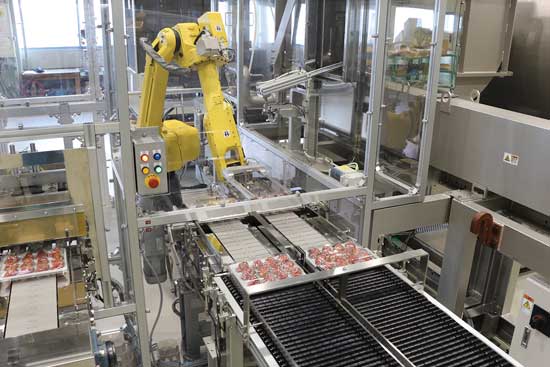 A brand-new electron beam fruit irradiation system will make its U.S. debut at the Shibuya Hoppmann booth. Built this year in Japan, the system is designed to irradiate strawberries, destroying microorganisms on the surface of the fruit and extending shelf life up to 14 days or more. The new system has a small footprint, eliminates the need for chemical fumigation of fruit, and, because it does not penetrate the fruit, has no impact on product quality. In addition to displaying the emitter module of the system, the Shibuya Hoppmann booth will feature literature and videos detailing its patent-pending technology. Shibuya Hoppmann, shibuyahoppmann.com, Booth 4720
A brand-new electron beam fruit irradiation system will make its U.S. debut at the Shibuya Hoppmann booth. Built this year in Japan, the system is designed to irradiate strawberries, destroying microorganisms on the surface of the fruit and extending shelf life up to 14 days or more. The new system has a small footprint, eliminates the need for chemical fumigation of fruit, and, because it does not penetrate the fruit, has no impact on product quality. In addition to displaying the emitter module of the system, the Shibuya Hoppmann booth will feature literature and videos detailing its patent-pending technology. Shibuya Hoppmann, shibuyahoppmann.com, Booth 4720
Innovative GEA Group processing solutions for preparing, separating, further processing, preserving, chilling, packaging, and freezing span virtually all food industry markets—ingredients, fruits and vegetables, oils, starch, sweeteners, confectionery, bakery, frozen food, meat, poultry, seafood, and more. In fact, the company estimates that about 70% of all food sold in supermarkets has been in contact with its technology. All GEA food processing equipment is designed to meet optimum hygiene and quality standards. Project management, planning, and cost control services complement the company’s technical expertise. GEA Group, gea.com, Booth 1607
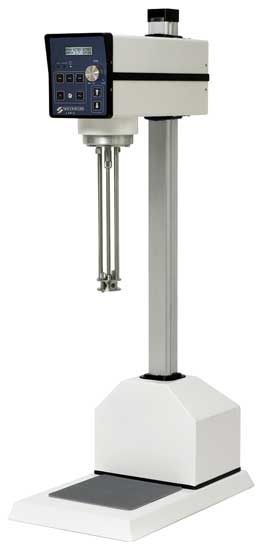 The L5M-A lab mixer from Silverson, the company’s newest model, is suitable for research and development work, quality assurance analysis, or small-scale production within any sector of the food processing industry. Designed for flexibility, Silverson high shear lab mixers can be used for mixing, emulsifying, homogenizing, disintegrating, and dissolving. Forty different interchangeable mixing assemblies are available for the L5M-A, which features touchpad control, has capacity from 1 mL to 12L, and flow rates up to 20 L/min. Silverson Machines, silverson.com, Booth 3350
The L5M-A lab mixer from Silverson, the company’s newest model, is suitable for research and development work, quality assurance analysis, or small-scale production within any sector of the food processing industry. Designed for flexibility, Silverson high shear lab mixers can be used for mixing, emulsifying, homogenizing, disintegrating, and dissolving. Forty different interchangeable mixing assemblies are available for the L5M-A, which features touchpad control, has capacity from 1 mL to 12L, and flow rates up to 20 L/min. Silverson Machines, silverson.com, Booth 3350
Resin-set dual retention system brushware ensures full and even coverage and allows for quick and effective cleaning. These brushes use stainless steel staples to secure tufts into a recessed brush back, which is then treated with a food-contact-approved epoxy resin. Dissipating the resin between brush filaments ensures that bacterial hotspots are eliminated. Biomaster’s antibacterial technology additive enhances the brushes’ bacterial defense system. The Hill Brush Co., hillbrush.com, Booth 4412
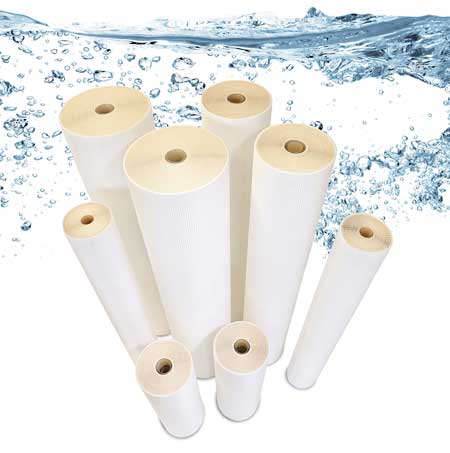 Celebrating 50 years in the business of providing filtration solutions to the food industry, Microdyn-Nadir offers a wide range of membrane configurations, including spiral wound, flat sheet, hollow fiber, tubular, and MBR modules. The company’s SPIRA-CEL spiral wound membranes are noted for their high flux, high protein retention, and long lifetimes. Standard and custom sizes that are USDA-accepted and meet FDA requirements are available. Microdyn Technologies, microdyn-nadir.com, Booth 4740
Celebrating 50 years in the business of providing filtration solutions to the food industry, Microdyn-Nadir offers a wide range of membrane configurations, including spiral wound, flat sheet, hollow fiber, tubular, and MBR modules. The company’s SPIRA-CEL spiral wound membranes are noted for their high flux, high protein retention, and long lifetimes. Standard and custom sizes that are USDA-accepted and meet FDA requirements are available. Microdyn Technologies, microdyn-nadir.com, Booth 4740
New ribbon blender from Munson, model HD-3.5-7-S316, blends up to 65 cu ft of powders, pastes, or slurries. Made of stainless steel, the blender forces a split double-helical agitator through stationary material, producing homogeneous blends, typically in five to six minutes. Tight tolerances between ribbon blades and the vessel wall minimize residual product in the trough following discharge, which reduces waste and cleaning time. The blender’s 2:1 length-to-diameter ratio is said to distribute ingredients uniformly during loading, blending, and discharge. Other mixing and blending equipment available from Munson includes paddle blenders, cylindrical plow blenders, and rotary batch mixers. Munson Machinery Co., munsonmachinery.com, Booth 3741
Aseptic and extended shelf-life processing and contract manufacturing are available from HP Hood. The company uses state-of-the-art ultra-high-temperature manufacturing with current and emerging packaging technologies to provide a variety of branded and private label products, including fluid dairy, citrus, cultured foods, frozen desserts, and extended-shelf-life dairy and nondairy beverages. HP Hood, hphoodmanufacturing.com, Booth 4362
Miniature-scale research and development systems for the food, beverage, and dairy industries are available from Armfield. Designed to replicate manufacturing processes in a laboratory, the company’s equipment systems enable R&D teams to test product formulations quickly and cost effectively. Armfield’s equipment assortment includes HTST/UHT/aseptic systems, carbonator/filler-cappers, spray dryers, spray chillers, multifunction batch processors, ice cream freezers, margarine crystalizers, extractors, edible oils processors, and ultrafiltration technology among others. Armfield Ltd., explorearmfield.com, Booth 1654
A new heat treatment for dry powdered goods carried out via conduction and convection is nontoxic, all-natural, and environmentally safe with the ability to restore products to spec, maintain food standard certifications, and extend shelf life while keeping original packaging intact. In this process, heat is absorbed by a product’s outer surface and moves to the center, causing dehydration of microbial molecules. Thus, essential cell constituents are dried up and destroyed, killing microorganisms. Also new from PacMore is the addition of extrusion to its range of contract manufacturing services, which include dry blending, spray-drying, and consumer packaging. PacMore, pacmore.com, Booth 3855
 Tara McHugh, PhD, Contributing Editor
Tara McHugh, PhD, Contributing Editor
Research Leader, USDA Agricultural Research Service, Albany, Calif.
[email protected]


